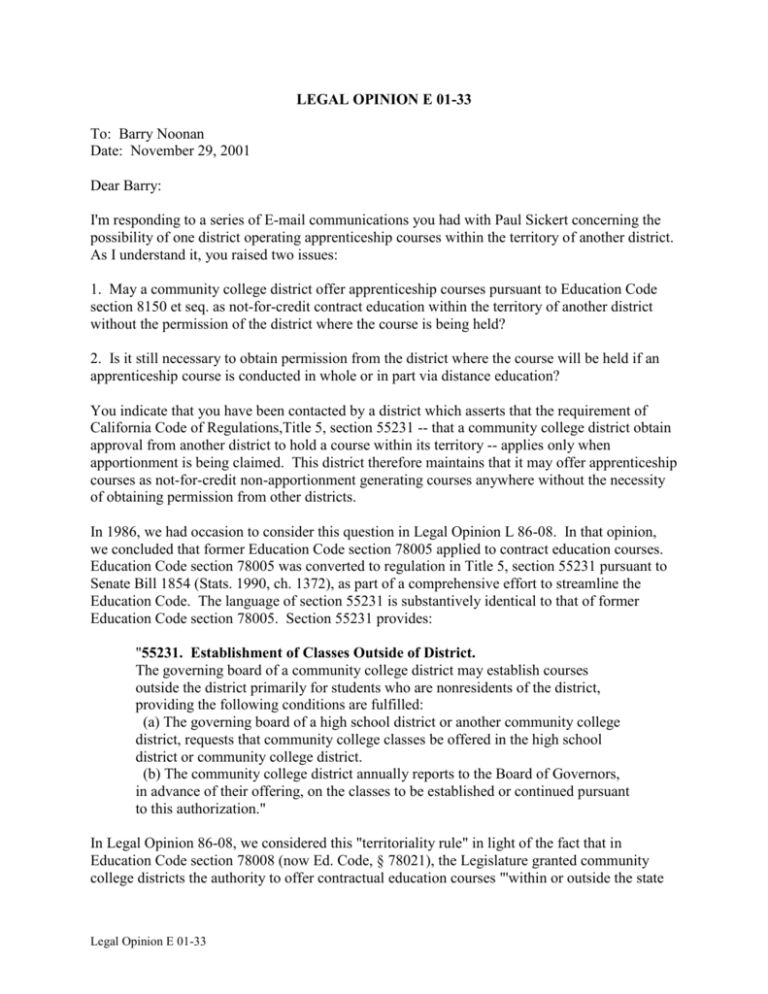STATE OF CALIFORNIA
advertisement

LEGAL OPINION E 01-33 To: Barry Noonan Date: November 29, 2001 Dear Barry: I'm responding to a series of E-mail communications you had with Paul Sickert concerning the possibility of one district operating apprenticeship courses within the territory of another district. As I understand it, you raised two issues: 1. May a community college district offer apprenticeship courses pursuant to Education Code section 8150 et seq. as not-for-credit contract education within the territory of another district without the permission of the district where the course is being held? 2. Is it still necessary to obtain permission from the district where the course will be held if an apprenticeship course is conducted in whole or in part via distance education? You indicate that you have been contacted by a district which asserts that the requirement of California Code of Regulations,Title 5, section 55231 -- that a community college district obtain approval from another district to hold a course within its territory -- applies only when apportionment is being claimed. This district therefore maintains that it may offer apprenticeship courses as not-for-credit non-apportionment generating courses anywhere without the necessity of obtaining permission from other districts. In 1986, we had occasion to consider this question in Legal Opinion L 86-08. In that opinion, we concluded that former Education Code section 78005 applied to contract education courses. Education Code section 78005 was converted to regulation in Title 5, section 55231 pursuant to Senate Bill 1854 (Stats. 1990, ch. 1372), as part of a comprehensive effort to streamline the Education Code. The language of section 55231 is substantively identical to that of former Education Code section 78005. Section 55231 provides: "55231. Establishment of Classes Outside of District. The governing board of a community college district may establish courses outside the district primarily for students who are nonresidents of the district, providing the following conditions are fulfilled: (a) The governing board of a high school district or another community college district, requests that community college classes be offered in the high school district or community college district. (b) The community college district annually reports to the Board of Governors, in advance of their offering, on the classes to be established or continued pursuant to this authorization." In Legal Opinion 86-08, we considered this "territoriality rule" in light of the fact that in Education Code section 78008 (now Ed. Code, § 78021), the Legislature granted community college districts the authority to offer contractual education courses "'within or outside the state Legal Opinion E 01-33 Barry Noonan 2 November 29, 2001 by agreement with any public or private agency, corporation, association or any other person or body …'." (L 86-08 4/16/86 citing Ed. Code, § 78008, now Ed. Code, § 78021.) The rules of statutory construction state that a conflicting specific statute takes precedence over a general one. (Warne v. Harkness (1963) 60 Cal.2d 579, 588; In re Williamson (1954) 43 Cal.2d 651, 654; Maloy v. Municipal Court (1968) 266 Cal.App.2d 414, 418.) It follows that since then Education Code section 78008 and now Title 5, section 55231, provides specific details as to when a community college district can offer courses in another district’s territory, the authorization to provide contract courses is subject to the specific provisions in Title 5, section 55231. In Barnhart III v. Cabrillo Community College (1999) 76 Cal.App.4th 818, the court had the opportunity to discuss the special status of statutes converted into regulations under Senate Bill 1854 (Stats. 1990, ch. 1372). The court reasoned that because these regulations were adopted by the Board of Governors pursuant to the Legislature’s mandate "to keep in effect the 'requirements, rights, responsibilities, conditions, or prescriptions' of an identical repealed statute. . . . [These converted regulations] .must be deemed to have equal dignity [with the identical repealed statute]." (Barnhart III v. Cabrillo Community College, supra, 76 Cal.App.4th 818, 825, citing Stats. 1990, ch. 1372, § 708, p. 6321.) Since Title 5, section 55231 has the full force of law and equal standing with former Education Code section 78005, the rationale and conclusion reached in Opinion L 86-08 remains valid. Nor do we see anything in section 55231 that would justify a different result with respect to notfor-credit contract education courses that are not claimed for state apportionment. Therefore, we hold that Title 5, section 55231 applies to all contract education courses, including those which are offered on a not-for-credit basis and are not claimed for purposes of state apportionment. Thus, in accordance with section 55231, prior to offering any course -- including not-for-credit, non-apportionment, contract education courses -- within the territory of another community college district, a community college district must seek and secure the permission of the community college district or high school district in which the course will be held. We do not see anything in Education code sections 8150 et seq. or Labor Code section 3074, which govern apprenticeship programs, that would require a different conclusion for such programs. (See 56 Ops.Cal.Atty.Gen. 95, 100-101 (1973), apprenticeship classes to be structured and administered similarly to any other classes offered by the schools.) You have also asked whether the result would be different for a course conducted partly or entirely as distance education pursuant to Title 5, section 55370 et seq. Answering this question requires a brief discussion of the ways in which distance education is conducted. There are a variety of technologies which now permit instruction to be provided at a distance. These include, but are not limited to, broadcast television, fully interactive video hook-ups, and instruction provided through the Internet. Sometimes students participate from home or work and in other cases they gather at a specific location and interact as a group with an instructor by means of a closed-circuit or satellite uplink connection. In all cases, distance education courses must be separately approved by the college curriculum committee (Cal. Code Regs., tit. 5, § Legal Opinion E 01-33 Barry Noonan 3 November 29, 2001 55378), must meet the same standards of rigor (Cal. Code Regs., tit. 5, § 55372) and be taught by instructors possessing the same qualifications as are applicable to traditional courses (Cal. Code Regs., tit. 5, § 55380). As indicated above, former Education Code section 78005, the predecessor to current Title 5 section 55231, was written long before the advent of modern instructional technologies and this is the first time we have considered how to interpret that provision in conjunction with the subsequent authorization by the Board of Governors for districts to conduct instruction by means of distance education. However, the rules of statutory construction compel us to make every effort to harmonize statutes and regulations so as to give effect to the intent of all enactments wherever possible. Section 55231 allows a district to offer courses within the territory of another district only when "The governing board of a high school district or another community college district, requests that community college classes be offered in the high school district or community college district." We think that the question here is whether a distance education course can be said to be located "in" another district. The answer to that question is that it depends on the way the course is structured and the technology it employs. If a course is broadcast or conducted over the Internet and students may participate from their homes or from any other location, then it cannot be said that the course is “located” in any particular geographic location, within another district or otherwise. In our view, such courses may be offered by a district without obtaining permission from other districts pursuant to section 55231. However, where some or all of the students gather in a specific location which is within the boundaries of a particular district, we believe section 55231 requires the sponsoring district to obtain permission from the community college or high school district where the course is located. I hope this information is helpful. Sincerely, Ralph Black General Counsel RB:sj E 01-33 Legal Opinion E 01-33









